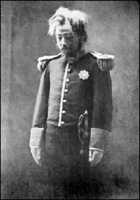![]()
Historical Perspective
 |
|
American misconception #4 The single greatest American failing in regard to Shakespeare production is the idea that, in order to make Shakespeare more palatable to American audiences, graphic and convenient parallels have to be found. The American genius for innovation and experiment hits its nadir in the weird and grotesque permutations American directors foist on the plays in their misguided attempts to popularize them. In most cases, these are external 'period' changes -- the old works gussied up in the most unexpected attire and set in the most startling 'new' settings. --- Charles Marowitz, Recycling Shakespeare, Applause Books, N.Y, 1991, p.118 |
Reaction against reaction against reaction. With the publication of his landmark book, Shakespeare Our Contemporary, Jan Kott expressed a conviction that the times shape the text. If a work is to endure, according to Kott, it will continually be preceived through the filter of differing experiences of life afforded by differing times and circumstances. For works that are passed along as text, that means that the images generated in the mind of their readers will continuously vary. Theater, however, repeatedly reconstitutes text into production with the result that the same text continuously generates new works. In his introduction to Kott's book, Martin Esslin explains the basis for Kott's thought.
|
Great works of art have an autonomous existence, independent of the
intention and personality of their creators and independent also of
the circumstances of the time of their creation, that is the mark of
their greatness. The tragedies of Aeschylus, the paintings of El Greco,
the poems of John Donne have a significance to twentieth-century man
of which the contemporaries of their creation could not have had the
remotest notion. |
From the early 1960's onward, Kott's argument had a great influence on directors, and helped engender an enormous number of 'concept' productions; productions characterized (and lampooned) by Charles Marowitz. In retrospect, many concept productions do look ridiculous, and there is a great move to discredit them in the beginning of the twenty-first century. What is interesting, is that Kott's work came in reaction to a historicity that dominated our thinking about Shakespeare's work at the end of the nineteenth century. A good example of the historical approach can be seen in Thomas Alfred Spalding's writing on Elizabethan ghost-lore.
|
The student must endeavour to divest himself, as far as possible, of
all ideas that are the result of a development subsequent to the time
in which his author lived, and to place himself in harmony with the
life and thoughts of the people of that age: sit down with them in their
homes, and learn the sources of their loves, their hates, their fears,
and see wherein domestic happiness, or lack of it, made them strong
or weak; follow them to the market-place, and witness their dealings
with their fellows -- the honesty or baseness of them, and trace the
cause; look into their very hearts, if it may be, as then kneel at the
devotion they feel or simulate, and become acquainted with the springs
of their dearest aspirations and most secret prayers. |
It is easy to see how this position sits diametrically opposite from that of Jan Kott. Following this cue, John Dover Wilson applies the historical perspective specifically to the ghost in Hamlet.
|
Shakespeare spent much thought upon this unique creature of his imagination;
he made it an epitome of the ghost-lore of his age. The majesty of buried
Denmark is an English spirit, English of the late sixteenth and early
seventeenth centuries, and the story of Hamlet turns upon this fact.
Thus, unless we can see it as the Elizabethans did, we shall inevitably
miss, not only many beautiful touches, but, more important still, matters
which concern the plot of the play, to which the Ghost is intimately
related, seeing that he is the instrument which sets it in motion. |
You will see in the following screens how John Dover Wilson uses this seemingly outdated approach to come up with some startlingly modern insights into the role of the ghost in Shakespeare's play.